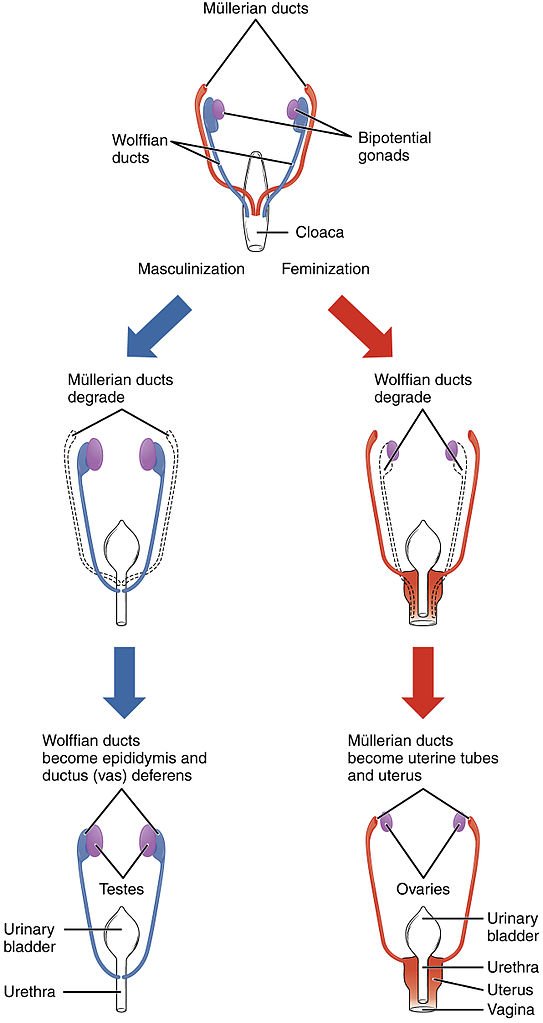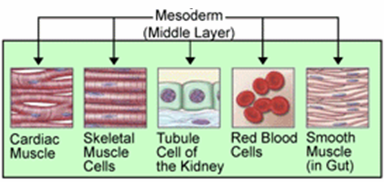Men; Y'all Would Be Females But For... (Pink Turns Blue)
A good number of persons get upset at this idea for varied reasons; male supremacy is an instance. If you had paid attention in your biology class, you probably may have known this; all life forms begin as females in the womb. So, it's just biology, not me.
Hilda Bird, Lagos, Portugal. The ovaries produce female egg cells of the dominant X chromosome. This seemingly inactive chromosome plays a key role in the embryo development up until the 7th to 12th weeks of gestation when the X or Y chromosome contained in the sperm cell that fertilized the egg starts to play its due active role in foetal development. This means that the embryo begins as a female until the manifestation of the Y gene puts a stop to the growth of feminine structures in males. A key factor in the growth of male genitals is the SRY (Sex Determining Region on Y); an isolated testis determining gene in humans contained in the Y chromosome. All babies will develop female sex organs but for the imposition of the Y chromosome. According to Wikipedia, Sexual differentiation in humans is the process of development of sex differences in humans. It is the process of development of the differences between males and females from an undifferentiated zygote and is also defined as the development of phenotypic structures consequent to the action of hormones produced following gonadal determination. Worthy of mention among these in relation to sexual differentiation are: Remarkably, the mesonephros is a leading determinative factor in the differentiation of sex organs. The Mesonephros meaning 'middle kidney' in Greek is what remains after the atrophy of the pronephros. It acts as a temporary embryonal kidney in mammals producing urine from the 6th week through the 10th week of foetal development to disappear when the permanent kidney; the metanephros starts to develop. Paramesonephric or Müllerian Duct The Genital or Gonadal Ridge. In Females In Males According to Alfred Jost (1976), "male characteristics must be imposed on the fetus by the testicular hormones testosterone and MIS, respectively, which are responsible for the virilization of the mesonephral ducts, urogenital sinus and external genitalia as well as for regression of the Mullerian ducts. In the absence or inactivity of these hormones, the development of the fetus is stalled at an indifferent stage; thus, it becomes phenotypically female." The exposure of the fetal brain to sexual hormones have a resounding effect on brain structure and function. Since both androgen receptors and estrogen receptors have been identified in brains, the absence of large quantities of androgen in a female foetus would leave the brain more exposed to estrogen; the feminine sexual hormone and the presence of large quantities of androgen and testosterone in male foetus will also lead to the exposure of the brain to the male sexual hormone. These help in proper differentiation which would ultimately correlate with adult reproductive behavior. Brain areas that show sex differences that relate to gender include the bed nucleus of the stria terminalis, the third interstitial nucleus of the anterior hypothalamus, and the shape of the corpus callosum (Saraswat et al. 2015). Exceptions exist however as they are known to with almost everything under the sun. Research has shown that some persons respectively have a collection of different combinations of sex chromosomes and genes, especially those who belong to the LGBT. Furthermore, researches have also found that abnormality in gonadal, chromosomal and biological sex developments can result in natural conditions which are termed DSD (Disorders of Sex Development). Thanks for reading. References / Further reading 1. The Biology of Human Gender. 2. Why do men have nipples? | notes and enquiries. 3. Wikipedia | Sexual Differentiation. 4. Wikipedia | Paramenosephric ducts. 6. 15 things to know about how baby genitals develop 9. Development of the Urogenital Region. 10. Studies of Gonadal Sex Differentiation.
Pixabay

All humans begin life in the womb as females. If no Y chromosome is present in the foetus, then the embryo will continue to develop as and be born as a female. If there is a Y chromosome present in the embryo, the male sex hormone testosterone restricts the full development of breasts to just nipples, the labia fuse to become the scrotum and clitoris develops fully to become a penis. If the Y chromosome prevails in producing a male, this is not done without a fight...

From the Top on Sexual Differentiation.

Wikipedia : Sexual Differentiation
The mesoderm is the middle one of the three primary germ layers in the very early embryo. This intermediate mesoderm differentiates into urogenital structures. The urogenital system forms a urogenital ridge on the right side of the aorta which develops into the gonadal or genital ridge, the paramesonephric duct, gubernaculum, and three sets of tubular nephric structures namely the pronephros which mostly reverts, the mesonephros and the metanephros among others.
Wikipedia : Mesoderm
This paired ducts of the embryo in the female, develop to form the uterine tubes, the cervix, the uterus and upper one-third of the vagina. They are however lost in the male.
Before the 7th-12th week of gestation when sexual genitals develop, the embryo has what is called a "genital ridge" also known as gonadal ridge in embryology. The genital/gonadal ridge is classified as ' sexually indifferent' because it has neither female nor male morphological characteristics and is a harbinger to the sex organs. It forms the indifferent sex organ or gonad which later differentiates into testis or ovaries.Sex Differentiation in Male and Female.
The lower parts of the mesonephric ducts regress in females due to the absence of androgens which are testicular hormones. The upper part as well as other tissues that have developed from the mesonephric duct remain to serve other functions.
The paramesonephric ducts on the other hand multiply and differentiate in a process that results in the formation of the the uterine tubes, the cervix, the uterus and upper one-third of the vagina.
The multiplication of the mesonephric ducts in the gonads result in their masculinization to testis under the influence of the SRY gene on the Y chromosome. In boys, the penis, prostate, and scrotum are formed during these fetal weeks 7–12.Sex Brain Receptors
